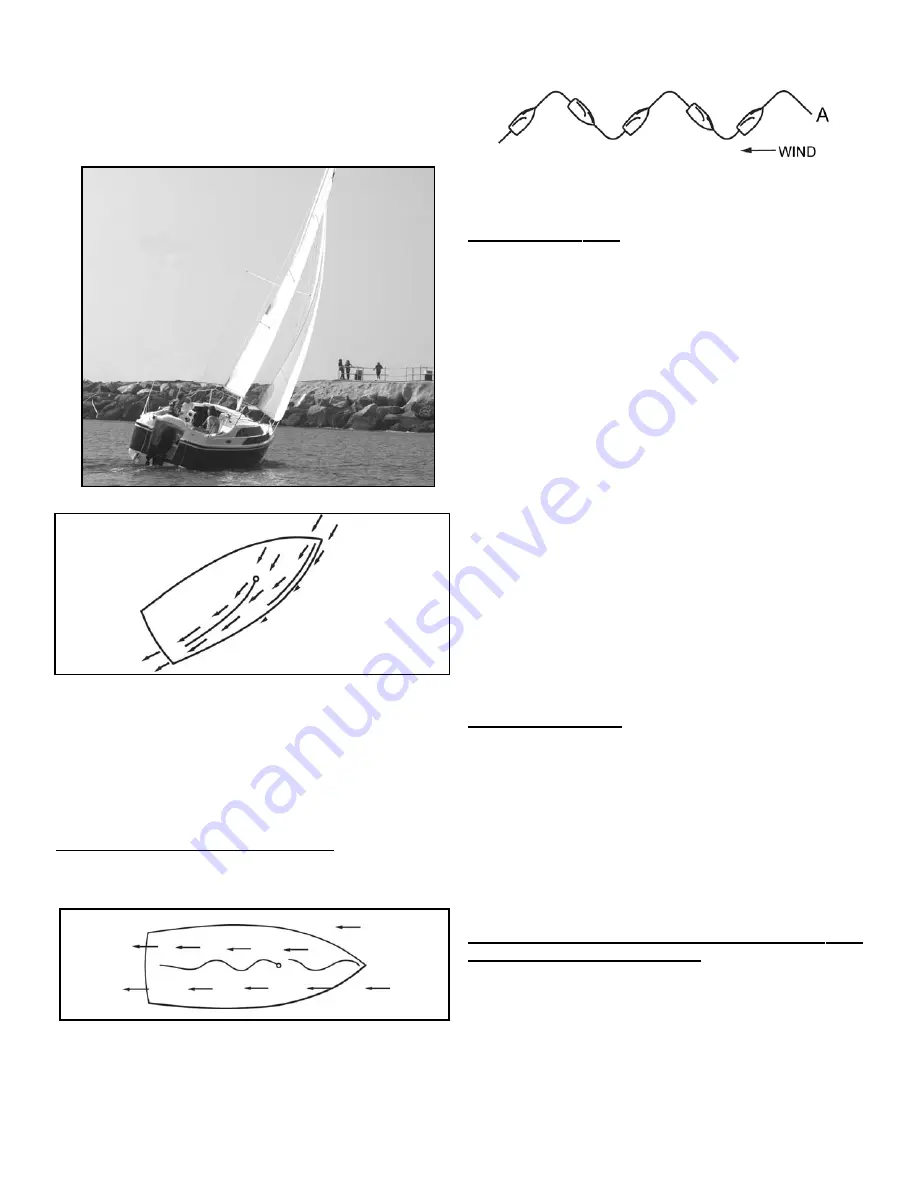
wind, except that the sails are pulled in closer to the centerline of
the boat, and you are now trying to sail as close into the wind as
you can. This is tougher to do, and the boat won’t go as fast as
when sailing across the wind. The following drawing shows the
boat sailing toward the wind. This is as close into wind as you are
going to get.
Sailing into the wind
Notice the smooth wind flow across the sails, and the lack of tur-
bulence. Wind is being properly diverted toward the rear of the
boat, and like the blast of air coming out of the rear of a jet, push-
ing the boat forward and sideways. More of the force is now side-
ways, so the boat will tend to lean more, but it will still squirt for-
ward, since the daggerboard is keeping it from going sideways.
SAILING STRAIGHT INTO THE WIND
. You can’t. The
sails will flap like flags, divert no wind, and you will just sit there,
frustrated, dead in the water. This is being in “irons”.
Trying to sail , unsuccessfully, straight into the wind.
So how do you get to point A in the above drawing if you can’t
sail directly toward it. You zig zag, (tack) like this.
Zig zagging (tacking) into the wind
THE FIRST DAY OUT
. Launch the boat on a nice day with a
light breeze. There should be just enough wind to move the boat
around. (You have to be moving if you expect the rudder to
work.) Fill the ballast tank. Make sure the rudders and dagger-
board are all the way down. Start the engine. Power slowly out to
the middle of a calm body of water, where there is nothing to
bump into, point into the wind, and put up the mainsail. Keep the
engine running slowly, moving the boat about 2 mph. With the
engine running and moving the boat forward, try to duplicate what
you see in the above diagrams. Sail with the wind, across the
wind and as close into the wind as you can go. Blunder around
like this for a while, trying to match the angle of the boom to the
wind as you see in the diagrams. After a half hour or so of this,
you will get a good feel of what works and what doesn’t. If you
screw up, or the sails shove the boat in a direction that you don’t
wish to go, overpower the sails with the engine. Use reverse if
you have to stop. In a tug of war between the engine and the sails
in moderate winds, the engine will win.
Then raise the jib. Remember that the jib control line is pulled in
on the side of the boat away from the wind. The line going to the
other side is left loose. As you zig zag into the wind (tacking),
you will have to release the jib line (sheet) from one side and pull
it in on the other. The mainsail control line (mainsheet) takes care
of itself. You don’t have to reset it each time you turn through the
direction from which the wind is blowing.
STOPPING THE BOAT
. If you are sailing, with the engine off,
you can always stop the boat by turning into the wind and letting
go of the jib control line and the mainsail control line. When you
do this, the wind pressure is off of the sails, the boat will coast a
few more boat lengths and come to rest. This also is good for
docking when the dock is upwind. A motor is better.
HOW DO YOU KNOW IF THE SAILS ARE SET AT THE
PROPER ANGLE TO THE WIND?
There are some simple
tricks that are used by the experts. When sailing in the same
direction as the wind (called “running”), just let the sails out until
they are at right angles to the wind. You are trying to catch as
much wind as possible. Unfortunately, the mainsail blocks the
wind from hitting the jib, so the jib will just hang, unless you can
hold it out on the opposite side of the mainsail, as shown below.
This adds sail area, but it only works when the wind is coming
from directly behind the boat.
Page 23
Summary of Contents for 26 M 2009
Page 28: ...Page 28...






































